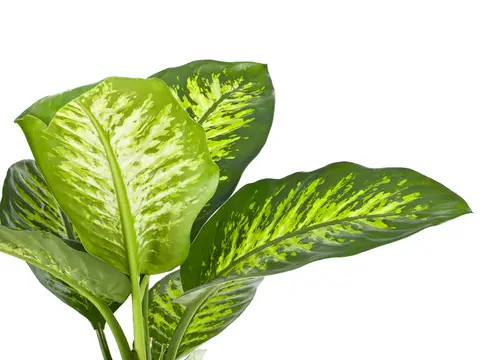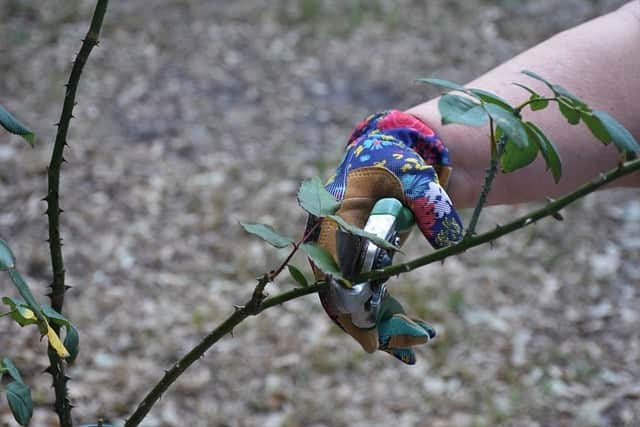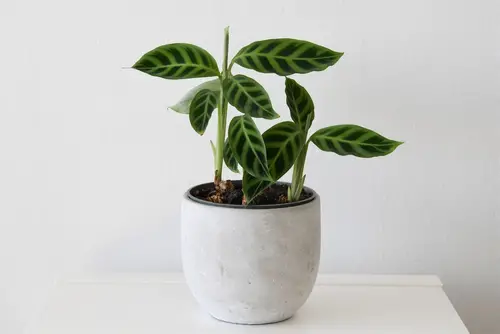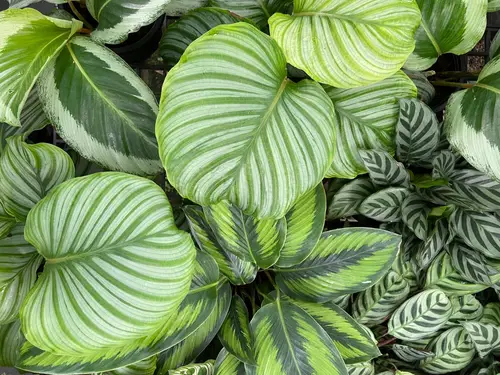White spots on plant leaves can be a common problem for outdoor gardeners. These spots can be caused by a variety of factors, including fungal diseases, environmental factors, and pests. It is important for gardeners to understand the causes of white spots on plant leaves in order to prevent and treat the problem effectively.
Fungal diseases are one of the most common causes of white spots on plant leaves. Powdery mildew, for example, is a fungal disease that can cause white spots on leaves, stems, and flowers. This disease is caused by a variety of fungi and can affect a wide range of plants.
Other fungal diseases that can cause white spots on plant leaves include downy mildew and rust. In addition to fungal diseases, environmental factors such as high humidity and poor air circulation can also contribute to the development of white spots on plant leaves.
Understanding the causes of white spots on plant leaves is the first step in preventing and treating the problem. By identifying the type of fungal disease or environmental factor that is causing the white spots, gardeners can take appropriate measures to prevent the problem from occurring in the future.
Treatment options for infected plants will vary depending on the cause of the problem, but may include pruning infected leaves or applying fungicides. By taking proactive measures to prevent and treat white spots on plant leaves, gardeners can ensure that their outdoor plants remain healthy and vibrant.
Key Takeaways on White Spots on Plant Leaves Outdoors
- White spots on plant leaves can be caused by fungal diseases, environmental factors, and pests.
- Identifying the cause of white spots is important for preventing and treating the problem effectively.
- Treatment options for infected plants may include pruning infected leaves or applying fungicides.
Also don’t miss:
Understanding White Spots on Plant Leaves

White spots on plant leaves can be a sign of a few different issues, including fungal diseases, pests, or environmental stress. Identifying the cause of the white spots is crucial to treating the problem and preventing it from spreading to other plants.
One common cause of white spots on plant leaves is powdery mildew. This fungal disease appears as circular white spots or a white powdery coating on the leaves. It can affect a variety of plants, including vegetables, flowers, and shrubs. Powdery mildew thrives in warm, humid conditions and can spread rapidly if left untreated.
Another fungal disease that can cause white spots on plant leaves is downy mildew. This disease appears as white fuzz or mold on the undersides of leaves, and can cause yellowing or browning of the affected foliage.
Downy mildew is often caused by overwatering or poor drainage, and can be prevented by ensuring plants have adequate air circulation and proper watering.
In addition to fungal diseases, white spots on plant leaves can also be caused by pests such as spider mites or mealybugs. These pests can cause white or yellow spots on leaves, as well as other damage such as stunted growth or distorted leaves.
Proper pest control measures, such as using insecticidal soap or neem oil, can help prevent and treat these issues.
Finally, environmental stressors such as extreme heat or cold, drought, or improper fertilization can also cause white spots on plant leaves. These issues can be prevented by ensuring plants are properly cared for and receiving the right amount of water, nutrients, and sunlight.
Types of Fungal Diseases
Fungal diseases are a common problem for outdoor plants, causing white spots on plant leaves and other symptoms. There are several types of fungal diseases that can affect plants, including powdery mildew, downy mildew, and rot. Understanding the characteristics of each type of fungal disease can help gardeners identify and treat these issues effectively.
1. Powdery Mildew
Powdery mildew is a fungal disease that affects a wide range of plants, including vegetables, fruits, and ornamental plants. It is characterized by the appearance of white or gray powdery spots on the leaves, stems, and flowers of infected plants. The spots may also appear on the fruit of some plants.
Powdery mildew is caused by fungal spores that are spread by wind or water. It thrives in warm, humid conditions and can quickly spread throughout a garden. Gardeners can prevent powdery mildew by keeping plants well-spaced and ensuring good air circulation.
Fungicides can also be used to treat powdery mildew, but it is important to choose a product that is labeled for the specific type of plant being treated.
2. Downy Mildew

Downy mildew is another fungal disease that can cause white spots on plant leaves. It is characterized by the appearance of yellow or brown spots on the upper surface of leaves, with white or grayish-purple growth on the underside. Infected leaves may also curl or twist.
Downy mildew is caused by fungal spores that are spread by wind or water. It thrives in cool, damp conditions and can be particularly problematic in shaded areas.
Gardeners can prevent downy mildew by ensuring good air circulation and avoiding overhead watering. Fungicides can also be used to treat downy mildew, but it is important to choose a product that is labeled for the specific type of plant being treated.
3. Rot
Rot is a fungal disease that can cause white spots on plant leaves, as well as other symptoms such as wilting and discoloration. It is characterized by the appearance of soft, mushy spots on the leaves, stems, and roots of infected plants. The spots may also have a foul odor.
Rot is caused by fungal spores that are present in the soil. It thrives in warm, moist conditions and can be particularly problematic in poorly drained soil. Gardeners can prevent rot by ensuring good soil drainage and avoiding overwatering.
Fungicides can also be used to treat rot, but it is important to choose a product that is labeled for the specific type of plant being treated.
Identifying Infected Plants
White spots on plant leaves can be a sign of a fungal or bacterial infection. If left untreated, the disease can spread to other parts of the plant and even to nearby plants. It is important to identify the infected plants as soon as possible to prevent further damage.
The first sign of an infected plant is the appearance of white spots on the leaves. These spots may be circular or irregular in shape and can vary in size. The spots may also be accompanied by other symptoms such as yellowing of the leaves, wilting, twisting, and disfigurement of the leaves, stems, fruit, flowers, buds, and growing tips.
To identify an infected plant, it is important to inspect the leaves, stems, fruit, flowers, buds, and growing tips. Look for white spots on the upper and undersides of the leaves. Check for any discoloration or distortion of the leaves, stems, and fruit. If the plant is wilting or the leaves are turning yellow, it may be a sign of an infection.
It is important to note that not all white spots on plant leaves are a sign of an infection. Some plants, such as succulents, have natural white spots on their leaves. However, if the white spots are accompanied by other symptoms, it is likely that the plant is infected.
Effects of Environmental Factors

Environmental factors play a crucial role in the growth and development of plants. White spots on plant leaves can be caused by various environmental factors, including humidity, wind, air circulation, nutrients, and fertilizing.
Humidity and Moisture
High humidity and excess moisture can cause powdery mildew, a fungal disease that can lead to the appearance of white spots on plant leaves. It is important to avoid overwatering outdoor plants to prevent the growth of fungi.
Additionally, high humidity levels, especially at night, and temperatures between 70 to 80 °F (21 to 27 °C) can also cause powdery mildew.
Wind and Air Circulation
Poor air circulation can lead to the growth of fungi and bacteria, which can cause white spots on plant leaves. It is important to ensure that outdoor plants have adequate air circulation to prevent the growth of these microorganisms. Additionally, strong winds can damage plant leaves, leading to the appearance of white spots.
Nutrients and Fertilizing
Nutrient deficiencies can cause white spots on plant leaves. Plants require a balanced supply of nutrients to grow and develop properly. It is important to fertilize outdoor plants regularly to provide them with the necessary nutrients. However, too much fertilizer can also cause white spots on plant leaves.
Prevention and Control Techniques
To prevent and control white spots on plant leaves, there are several techniques that can be employed. Proper watering, pruning and air circulation, and the use of fungicides are all effective methods for preventing and controlling the spread of white spots on plant leaves.
1. Proper Watering
Proper watering is essential for preventing the spread of white spots on plant leaves. Overwatering can create a humid environment that is conducive to the growth of fungus. It is recommended to allow the soil to dry out between waterings and to ensure that indoor plant pots have good drainage.
Additionally, misting the plant or soaking the leaves should be avoided. Poor air circulation can also support the spread of powdery mildew. If plants are too close together, they’ll trap pockets of air, which can also raise the humidity.
2. Pruning and Air Circulation

Pruning and air circulation are also important for preventing the spread of white spots on plant leaves. Pruning can help to remove infected leaves and stems, which can prevent the spread of the fungus.
Additionally, it is recommended to provide adequate air circulation around the plants. This can be achieved by spacing plants properly and avoiding overcrowding. Good air circulation can help to prevent the growth of fungus by reducing humidity.
3. Use of Fungicides
The use of fungicides is an effective method for preventing and controlling white spots on plant leaves. There are several types of fungicides available, including sulfur, neem oil, copper, and potassium bicarbonate. It is important to follow label instructions carefully when using fungicides.
Additionally, it is recommended to use a spray bottle to apply the fungicide evenly over the affected leaves and stems. Some natural remedies, such as milk spray and mouthwash, can also be effective in controlling white spots on plant leaves.
4. Compost
Using compost in the garden can also help prevent the spread of white spots on plant leaves. Compost can improve soil health, which in turn can help plants to resist disease. Additionally, compost can help to retain moisture in the soil, which can reduce the need for frequent watering.
Commonly Affected Plants
White spots on plant leaves can be a common problem for gardeners and plant enthusiasts. The following plants are commonly affected by this issue:
Outdoor Garden Plants
- Roses: Powdery mildew is a fungal disease that often affects roses. It can appear as a white, powdery substance on the leaves and stems of the plant, causing them to become distorted and discolored.
- Squash and Cucumbers: Powdery mildew can also affect these types of plants, causing white spots to appear on the leaves. If left untreated, the leaves may turn yellow and die.
- Tomatoes and Peppers: White spots on the leaves of these plants can be a sign of powdery mildew. It can cause the leaves to become distorted and eventually fall off.
- Beans and Peas: White spots on the leaves of these plants can be caused by a variety of factors, including powdery mildew and bacterial leaf spot. In severe cases, the leaves may turn yellow and fall off.
Indoor Houseplants

- Begonias: Powdery mildew is a common problem for begonias, causing white spots to appear on the leaves. It can also cause the leaves to become distorted and eventually fall off.
- Nightshades and Eggplants: Powdery mildew can also affect these types of indoor plants, causing white spots to appear on the leaves. If left untreated, the leaves may turn yellow and die.
- Legumes: White spots on the leaves of these plants can be caused by a variety of factors, including powdery mildew and bacterial leaf spot. In severe cases, the leaves may turn yellow and fall off.
Treatment of Infected Plants
If a plant is infected with white spots on its leaves, it is important to take action to prevent the disease from spreading. The first step is to remove any infected portions of the plant.
This will help prevent the disease from spreading to other parts of the plant or to nearby plants. Infected leaves should be removed and disposed of properly, away from the garden area.
It is also important to care for the plant properly to help it thrive and avoid stress. Plants that are stressed are more susceptible to disease. Ensure that the plant is getting enough water, sunlight and nutrients. Yellow or dry leaves should be removed to prevent the disease from spreading and to help the plant focus on healthy growth.
There are several treatments available for white spots on plant leaves. For organic treatment, baking soda is an effective option. Mix one tablespoon of baking soda with one gallon of water and spray the foliage of the plant.
This will help prevent the disease from spreading and also help the leaves dry out, which will make it more difficult for the disease to thrive.
There are also chemical treatments available, but it is important to be careful when using these. They can be harmful to beneficial insects and can also lead to the development of resistant pests. If using chemical treatments, be sure to follow the instructions carefully and use them only as a last resort.
Prevention is the best method for control of white spots on plant leaves. Ensure that the garden area is clean and free of debris. Practice crop rotation, rotating vegetables every 3 years. This will help prevent the buildup of pests and disease in the soil.
Keep an eye out for pests and take action to control them before they can spread disease. By taking care of the plant and being proactive about prevention, it is possible to keep white spots on plant leaves under control.
Frequently Asked Questions

What causes white spots on outdoor plants?
White spots on outdoor plants are often caused by fungal diseases such as powdery mildew or downy mildew. These diseases thrive in humid and moist environments and can spread quickly. Other causes of white spots on outdoor plants include insect infestations, nutrient deficiencies, and sunburn.
How to treat white spots on leaves?
The treatment for white spots on leaves depends on the cause. If the spots are caused by a fungal disease, treatment usually involves applying a fungicide.
For insect infestations, using an insecticide can help eliminate the pests. Nutrient deficiencies can be addressed by fertilizing the plants with the appropriate nutrients. Sunburned leaves will not recover, but proper shading can prevent further damage.
What is the white stuff on my leaves outside?
The white stuff on outdoor leaves is often powdery mildew, a fungal disease that forms a white, powdery growth on the surface of the leaves. It is common in humid and moist environments and can spread quickly. Other causes of white stuff on outdoor leaves include downy mildew, insect infestations, nutrient deficiencies, and sunburn.
How to get rid of white spots on indoor plants?
Getting rid of white spots on indoor plants involves identifying the cause and using the appropriate treatment. If the spots are caused by a fungal disease, applying a fungicide can help eliminate the problem.
Insect infestations can be treated with an insecticide, while nutrient deficiencies can be addressed by fertilizing the plants with the appropriate nutrients. Sunburned leaves will not recover, but proper shading can prevent further damage.
What are the tiny white specks on plants?
Tiny white specks on plants are often caused by insect infestations. Common pests that cause white specks include spider mites, mealybugs, and whiteflies. These insects feed on the sap of the plants, leaving behind white specks or a white, powdery residue. Treating the plants with an insecticide can help eliminate the pests.
What insects cause white spots on plant leaves?
Several insects can cause white spots on plant leaves, including spider mites, mealybugs, and whiteflies. These insects feed on the sap of the plants, leaving behind white spots or a white, powdery residue. Treating the plants with an insecticide can help eliminate the pests.


